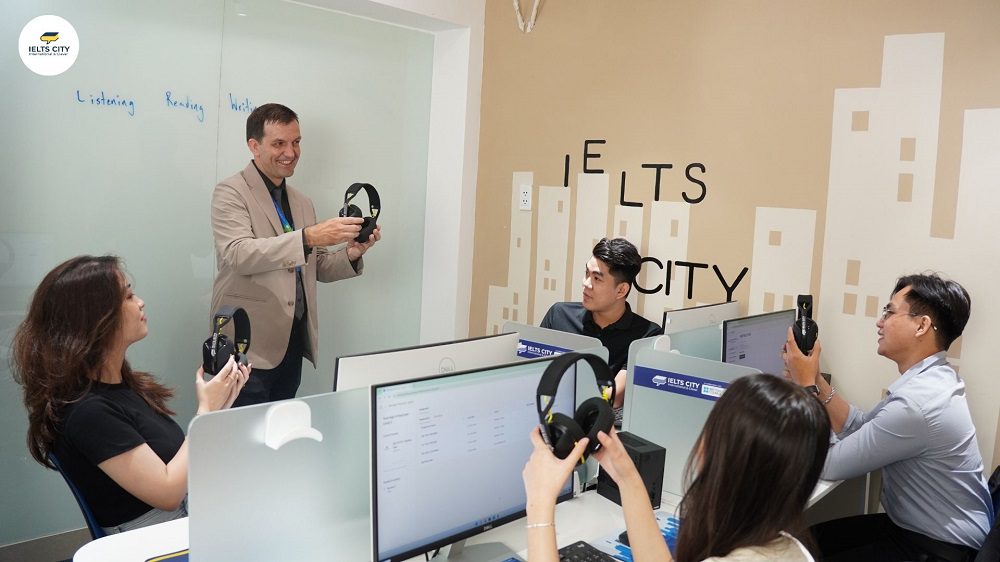Tại bài viết này, IELTS CITY sẽ hướng dẫn các bạn cách chia động từ số ít và số nhiều trong tiếng Anh một cách chính xác nhất. Cùng theo dõi nhé!

Nội dung chính
Toggle1. Các trường hợp chủ ngữ đứng tách khỏi động từ
Trong câu tiếng Anh, có những trường hợp khó xác định chủ ngữ của câu vì chủ ngữ và động từ không đứng gần nhau. Thông thường, một ngữ giới từ (một giới từ mở đầu với các danh từ theo sau) có thể xuất hiện giữa chủ ngữ và động từ, nhưng điều này không làm thay đổi cách chia động từ.
Ví dụ: The teachers in the room are preparing lesson plans.
Trong ví dụ trên, “in the room” là một ngữ giới từ, chủ ngữ của câu “the teachers” là danh từ số nhiều nên động từ tobe phía sau cần phải chia theo chủ ngữ “the teachers”, và động từ đó là “are”
Dưới đây là một số ví dụ khác:
- Studying languages is really interesting.
- Many ideas about this topic have been suggested.
- Thinking about these subjects changes over time.
- The problem of forest fires is very serious, so be careful.
Ngoài ra, các cụm từ đứng giữa chủ ngữ và động từ như là together with, along with, accompanied by, as well as được phân tách bằng dấu phẩy, cũng tạo thành hiện tượng đồng chủ ngữ và chúng cũng không có ảnh hưởng gì đến cách chia động từ.
Ví dụ:
- Tom, together with his siblings, is preparing for the school play.
- My sister, along with her classmates, is organizing a charity event.
- The professor, accompanied by his research team, is presenting at the conference.
- John, as well as his wife and kids, is joining the family reunion.
Khi có hai chủ ngữ đứng cùng nhau và được nối với nhau bằng “and,” động từ sẽ chia theo số nhiều như “they.”
Ví dụ:
- Tome and John are playing games.
- My friends and I are in the garden.
Tuy nhiên, khi dùng “or” để kết nối hai danh từ, động từ sẽ phụ thuộc vào danh từ ở gần nó nhất. Nếu danh từ đó là số ít, động từ sẽ ở dạng số ít, và ngược lại.
Ví dụ:
- I or my coworker is joining a meeting tonight.
- Every day, my sister or I am responsible for walking the dog.
2. Các từ luôn đi với danh từ hoặc đại từ số ít
Trong Tiếng Anh, có một vài từ luôn được theo sau bởi danh từ và đại từ số ít như :
*any + singular noun : anybody, anyone, anything.
*no + singular noun: nobody, no one, nothing.
*some + singular noun : somebody, someone, something.
*every + singular noun : everybody, everyone, everything.
*each
*either
*neither
Các từ này được theo sau bởi một động từ ngôi thứ 3 số ít
Note : Either và neither là số ít nếu chúng không đi với or hoặc nor
Ví dụ:
- Anybody joins the club if they meet the requirements.
- Anyone who’s interested volunteers.
- Anything is possible if you put your mind to it.
- Nobody wants to be left out.
- No one knows the answer.
- Nothing prepares me for what I see.
- Somebody leaves their jacket on the chair.
- Someone knocks at the door; could you answer it?
- Something smells delicious in the kitchen.
- Everybody is excited about the event.
- Everyone participates in the meeting.
- Everything goes smoothly during the presentation.
- Neither option seems suitable for our needs.
3. Cách sử dụng None of và No
- No : No được theo sau bởi danh từ cả danh từ đếm được (số ít và số nhiều) và danh từ không đếm được
- Nếu sau No là một danh từ đếm được số ít hoặc không đếm được thì động từ phải ở ngôi thứ 3 số ít.
- Nếu sau đó là một danh từ số nhiều thì động từ phải ở ngôi thứ 3 số nhiều
No + {singular noun / non-count noun} + singular verb
No + plural noun + plural verb
Ví dụ:
- No pets are allowed here.
- No milk is used in this drink.
- None of : None of được dùng trước mạo từ the, từ chỉ định (this, that), từ sở hữu (my, your) hoặc đại từ.
- Nếu sau các từ này là một danh từ đếm được số ít hoặc không đếm được thì động từ phải ở ngôi thứ 3 số ít.
- Nếu sau đó là một danh từ số nhiều thì động từ phải ở ngôi thứ 3 số nhiều
Ví dụ:
- None of his old friends know what happened to him.
- It doesn’t matter. None of it was your fault.
- None of the information was helpful.
4. Cách sử dụng cấu trúc either… or (hoặc…hoặc) và neither… nor (không…mà cũng không)
Trong khi sử dụng either… or (hoặc…hoặc) và neither… nor (không…mà cũng không), động từ theo sau được chia theo danh từ thứ hai (danh từ sau or hoặc nor)
Ví dụ :
- Neither the manager nor the employees were aware of the policy change. (động từ tobe (were) được chia theo chủ ngữ “employees”)
- Either Tina or John is going to the beach. (động từ tobe (is) được chia theo chủ ngữ “John”)
5. V-ing làm chủ ngữ
Khi V-ing làm chủ ngữ thì động từ theo sau được chia ở ngôi thứ 3 số ít.
Ví dụ:
- Swimming is a great form of exercise.
- Reading enhances your knowledge and imagination.
- Learning languages opens doors to new opportunities.
- Running in the morning energizes the body and mind.
- Skiing requires skill and balance.
- Writing helps express thoughts and emotions.
- Painting allows for creative self-expression.
- Teaching others is a rewarding experience.
V-ing được sử dụng khi muốn diễn đạt 1 hành động cụ thể xảy ra nhất thời . Tuy vậy, khi ta muốn diễn đạt bản chất của sự vật, sự việc thì phải dùng danh từ.
Ví dụ:
- Dieting is very popular today.
- Diet is for those who suffer from a certain disease.
Bên cạnh đó, động từ nguyên thể thêm “to” ( Verb to infinitive) cũng có thể được dùng làm chủ ngữ và động từ sau nó sẽ chia ở ngôi thứ 3 số ít. Nhưng thường thì người ta dùng chủ ngữ giả it để mở đầu câu.
Ví dụ:
To find the book is necessary for him = It is necessary for him to find the book.
6. Các danh từ tập thể
Một số danh từ trong Tiếng Anh được dùng để chỉ cả tập thể tuy nhiên chúng là danh từ số ít nên theo sau đó động từ cũng phải là ngôi thứ 3 số ít.
Các từ đó là:
| Congressfamilygroupcommitteeclassstaff troupe army company congregation | Organizationteamarmyclubgang corporation crowdfirm audiencecoalition | Governmentjurymajority*minoritypublicbandboardcastchoircrew |
Ví du:
- Congress talks about important things that affect the whole country.
- The family gathers for dinner together every Sunday.
- The group works well together on projects.
- The committee is looking at some suggested changes.
- The class talks about the readings they have to do each week.
- The organization tries to reach its goals by working together.
- The team practices a lot to get better at their sport.
- The army trains regularly to be ready for anything.
- The club plans fun events for its members.
- The crowd cheers loudly during live shows.
Tuy nhiên, các danh từ tập hợp trên còn được chia ở dạng số nhiều và động từ theo sau cũng ở dạng số nhiều. Điều này xảy ra khi chúng ta nghĩ về nhóm như là các cá nhân, mỗi người đều làm những việc khác nhau, hoặc khi chúng ta muốn nhấn mạnh vào sự khác biệt đang diễn ra trong nhóm.
- The family are doing different jobs around the house today.
Ở đây, mỗi thành viên cá nhân của gia đình đều đang làm một việc khác nhau. Vì vậy, chúng ta sẽ sử dụng động từ số nhiều ‘are ‘.
- The team are eating sandwiches for dinner.
Ở đây, một lần nữa, chúng ta nghĩ về “team” như là một nhóm các cá nhân. Họ có thể có các loại bánh mì khác nhau và họ không ai cũng ăn cùng cách vào cùng một thời điểm. Vì vậy, chúng ta sẽ sử dụng động từ số nhiều ‘are’.
* Danh từ majority được dùng tuỳ theo thành phần sau nó để chia động từ
The majority + singular verb
The majority of the + plural noun + plural verb
- The majority believes that we are in no danger.
- The majority of the students believe him to be innocent.
Ngoài ra, một số các loại danh từ tập hợp như sau cũng được theo sau bởi một động từ ngôi thứ 3 số ít
Chỉ người:
A pack of thieves broke into the jewelry store last night.
A group of protesters gathered outside the government building.
Các cụm từ khác :
- A board of directors
- A choir of singers
- A class of students
- A crowd of people
- A gang of thieves
- A pack of thieves
- A panel of experts
- A team of players
- A troupe of dancers
- A band of musicians
Đồ vật:
A pair of shoes was left on the sidewalk.
A set of keys is hung by the door.
Các cụm từ khác :
- A bouquet of flowers
- A bunch of flowers
- A fleet of ships
- A forest of trees
- A galaxy of stars
- A pack of cards
- A pack of lies
- A pair of shoes
- A range of mountains
- A wad of notes
Con vật:
- A school of fish swims gracefully through the coral reef.
- A flock of birds is flying overhead, creating intricate patterns in the sky.
Các cụm từ khác :
- An army of ants
- A flock of birds
- A flock of sheep
- A herd of deer
- A hive of bees
- A litter of puppies
- A murder of crows
- A pack of hounds
- A pack of wolves
- A school of fish
- A swarm of locusts
- A team of horses
- A pride of lions
Tên một tổ chức bao gồm nhiều người
WHO is responsible for coordinating international efforts to combat infectious diseases.
The United Nations works to promote peace and security worldwide.
Bên cạnh đó, trong Tiếng Anh chúng ta còn có các danh từ tập hợp dùng để chỉ thời gian, tiền bạc, số đo, … đều được xem là một danh từ số ít. Do đó được theo sau bởi động từ ngôi thứ 3 số ít
Ví dụ:
- Twenty-five dollars is the cost of admission to the museum.
- Fifty minutes is the duration of the school assembly.
- Twenty dollars is the price of the concert ticket.
- Two miles is the distance from my house to the nearest grocery store.
7. Cách sử dụng a number of, the number of
A number of (Một số… ) được theo sau bởi một danh từ số nhiều nên sau đó động từ cũng được chia ở số nhiều.
A number of + plural noun + plural verbs
Ví du:
- A number of students have expressed interest in joining the science club this semester.
- A number of complaints have been received regarding the noise levels in the neighborhood.
- A number of options are available for those seeking alternative transportation methods.
- A number of books have been published on the topic of sustainable living.
- A number of candidates are being considered for the vacant position within the company.
The number of (số lượng …) cũng được theo sau bởi danh từ số nhiều. Tuy nhiên, theo sau đó phải là một động từ ngôi thứ 3 số ít
The number of + plural noun + singular verb
Ví dụ:
- The number of students increases steadily with each session.
- The number of cars exceeds the available spaces during peak hours.
- The number of tourists remains steady despite occasional fluctuations in weather conditions.
- The number of participants continues to grow as the event date approaches.
8. Các danh từ luôn ở số nhiều
Có một số danh từ tiếng Anh mà luôn ở dạng số nhiều, kể cả khi chỉ đề cập đến một vật. Dưới đây là một số ví dụ:
- Scissors (kéo): The scissors are on the table.
- Trousers (quần): These trousers need to be hemmed.
- Pants (quần dài): My pants are too tight.
- Glasses (kính): Her glasses are missing.
- Jeans (quần jean): Those jeans are too faded.
- Tongs (đồ gấp): The tongs are used to grip hot food from the grill.
- Eyeglasses (mắt kính): His eyeglasses are essential for reading small print.
- Pliers (cây kìm): The pliers are kept in the toolbox for fixing various things around the house.
- Tweezers (cây nhíp): The tweezers are perfect for plucking out those pesky stray hairs.
Tuy nhiên nếu chúng ta muốn biến những từ này sang số ít chúng ta có thể dùng “a pair”. Lúc này, động từ đi sau đó phải là ngôi thứ 3 số ít.
Ví du:
- A pair of pants is in the closet.
9. Cách dùng there is, there are
Khi chỉ sự tồn tại của người hoặc vật tại một nơi nào đó chúng ta cần dùng “there + be +…”
Chủ ngữ thật của câu là là danh từ đi sau động từ. Vì thế, nếu đó là danh từ số ít thì động từ to be chia ở ngôi thứ 3 số ít và ngược lại.
There luôn được giữ nguyên, chúng ta chỉ thay đổi động từ tobe tùy theo các thì (tenses) khác nhau
{There is/ There was/There has been} + singular subject (or non-count) …
- There is a book on the table.
- There was a problem with the computer yesterday.
- There has been a change in the company’s policy recently.
- There is milk in the refrigerator.
- There was a cat sitting on the fence last night.
{There are/ There were/There have been} + plural subject …
- There are many books on the shelf.
- There were several cars parked in the driveway yesterday.
- There have been numerous complaints about the noise from the construction site.
- There are students waiting in the cafeteria for lunch.
- There were a lot of people at the concert last night.
Lưu ý:
There còn được dùng trong những cấu trúc sau :
- There is certain/ sure/ likely/ bound to be (chắc chắn là sẽ có ) + danh từ không đếm được hoặc danh từ số ít
Ví dụ:
- There is certain to be a delay due to the bad weather.
- With such heavy traffic, there is certain to be some congestion on the roads.
- With all the preparations, there is sure to be a fantastic party tonight.
- If you keep practicing, there is sure to be improvement in your skills.
- With the dark clouds, there is likely to be rain later in the day.
- If you don’t study, there is likely to be a low grade on your test.
- With so many people attending, there is bound to be some confusion at the event.
- If you leave your belongings unattended, there is bound to be someone who will take them.
- There + Động từ trạng thái/ Động từ chỉ sự đến + noun as subject
Động từ trạng thái (state verb): stand/ lie/ remain/ exist/ live
- There stands a majestic oak tree at the entrance to the park.
- In the corner of the room, there lies a pile of old books.
- In the forest, there exists a wide variety of plant species.
- Along the riverbank, there lives a family of otters.
Động từ chỉ sự đến (motion/arrival verbs): enter/ go/ come/ follow/ develop
- As we entered the room, there went a loud clap of thunder.
- In the distance, there goes the train, heading towards the city.
- Upon hearing the news, there came a sense of relief.
- Following the instructions, there went a surge in productivity.
- With each passing day, there develops a deeper understanding of the topic.
- There + subject pronoun + go/ come/ be: kìa/ thế là/ rồi thì
- There she goes, running to catch the bus.
- After hearing the good news, there we go, celebrating with a toast.
- With the sun setting, there she comes, walking along the beach.
- With the project completed, there he is, standing proudly next to his work.
- As the guests arrive, there they are, mingling in the garden.
- With the doorbell ringing, there she is, answering the door.
Vậy là IELTS CITY đã hướng dẫn các bạn chi tiết cách chia động từ số ít và số nhiều một cách chính xác nhất. Chúc các bạn luyện ngữ pháp tiếng Anh thành công nhé!
















